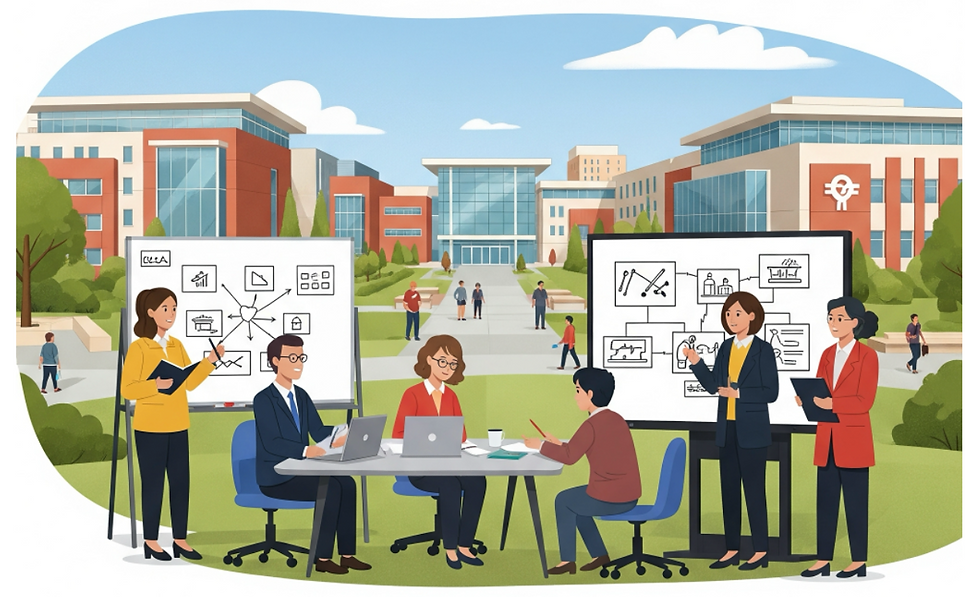Transforming Higher Education Through Lean Principles: A Collaborative Perspective
- Eric Olsen
- Aug 12
- 4 min read
Updated: Oct 29
In our recent discussion exploring the intersection of lean methodology and academic administration, we identified a critical pattern affecting universities nationwide: the inverse relationship between administrative growth and academic investment. This collaborative reflection examines how lean transformation principles can address these systemic challenges while preserving the core educational mission.
Prefer listening? We've created an AI-generated audio version that presents the key insights from Eric and Mark's discussion in podcast format. The Lean Lens episode synthesizes their conversation about administrative bloat, institutional challenges, and practical lean strategies into an accessible narrative. While this is an AI-produced summary rather than a direct recording of their dialogue, it captures the essential themes and makes the content available for those who prefer audio learning. Access the audio recording linked at the top of this post, or here.

Understanding the Current State: A Process Mapping Exercise
Through our combined experience across multiple institutions, we've observed consistent patterns in university operations. Faculty positions continue to decline dramatically while administrative structures expand. This trend represents a fundamental misalignment between resource allocation and value creation.
The lean principle of value stream mapping reveals the scope of this challenge. When we trace the flow of work through academic institutions, we discover that faculty members routinely work 60-hour weeks while navigating increasingly complex administrative requirements. Meanwhile, new policies emerge not from identified needs but from hypothetical compliance concerns—a classic example of push-based rather than pull-based systems.
Applying Systematic Process Improvement
Drawing from Central Coast Lean's workshop methodology and the Future of People at Work initiative's collaborative framework, we propose a structured approach to academic transformation:
1. Initial Assessment Phase
Document time allocation between value-adding activities (teaching, research, student mentoring) and administrative tasks
Map decision-making processes to identify redundancies and delays
Analyze the true cost of administrative complexity on educational outcomes
2. Collaborative Problem Identification Using techniques like A3 problem-solving, institutions can engage all stakeholders—faculty, staff, students, and administrators—in identifying systemic waste. Our discussion revealed that many administrative processes exist solely "in case we're audited" rather than to improve educational quality.
3. Development of Targeted Strategies The Cal Poly "Learn by Doing" philosophy offers a model for administrative excellence. By maintaining focus on hands-on education and practical application, institutions can resist bureaucratic expansion while enhancing educational value.
Building a Continuous Improvement Framework
The Future of People at Work initiative, uniting seven leading organizations committed to workplace transformation, has identified key principles for sustainable change:
Respect for People: Acknowledge that faculty expertise and dedication drive institutional reputation. Administrative structures should enable, not hinder, their work.
Data-Driven Decision Making: Track metrics that matter—student outcomes, faculty productivity in teaching and research, and genuine value creation—rather than compliance checkboxes.
Systemic Thinking: Recognize that every new administrative position or process affects the entire educational ecosystem. Apply lean's holistic perspective to evaluate true costs and benefits.
Implementing Kaizen in Academic Settings
Our shared experiences suggest specific improvement opportunities:
Streamline approval processes using pull systems that respond to actual needs rather than anticipated problems
Eliminate redundant reporting by creating single-source data systems
Empower faculty-led improvement teams to identify and eliminate daily frustrations
Apply mistake-proofing (poka-yoke) to administrative processes, reducing errors without adding complexity
Recommended Implementation Tools
Based on successful lean transformations in both corporate and academic settings:
Liberating Structures: Facilitate inclusive conversations about institutional priorities
Visual Management Systems: Make administrative processes transparent and accessible
Standard Work Documentation: Clarify essential tasks while eliminating non-value activities
Regular Gemba Walks: Encourage administrators to observe and understand faculty work firsthand
Creating Sustainable Excellence
The path forward requires acknowledging hard truths. Universities build reputations through faculty achievements and student transformations, not administrative efficiency metrics. As we noted in our discussion, prestigious institutions earn recognition through academic excellence, not bureaucratic sophistication.
Central Coast Lean's experience with pull-based workshop models offers a template: respond to genuine needs rather than creating solutions seeking problems. Similarly, universities must transition from push-based policy creation to pull-based support systems.
Expected Outcomes and Next Steps
Institutions embracing lean transformation can expect:
Reduced administrative burden on faculty
Improved resource allocation toward educational mission
Enhanced institutional agility and responsiveness
Stronger engagement from all stakeholders
The Future of People at Work initiative continues exploring these themes through strategic gatherings of senior leaders committed to systemic change. By bringing together decision-makers who understand both strategic vision and operational reality, we're building momentum for meaningful transformation.
Knowledge Map: Connecting to Your Context
This section helps readers identify how this content relates to their specific situation, bridging the gap between general insights and personal application.
Process Keywords: Value stream mapping • Pull-based systems • A3 problem-solving • Kaizen • Gemba walks • Standard work • Visual management
Context Keywords: Administrative bloat • Faculty workload • Compliance complexity • Policy proliferation • Resource allocation • Educational mission
Application Triggers: • Facing growing admin costs while cutting faculty → Value Stream Mapping & Assessment Phase • Faculty spending 60+ hours/week on non-teaching tasks → Streamline approvals & eliminate redundant reporting • Creating policies "in case we're audited" → Pull-based systems responding to actual needs • Planning institutional transformation → Continuous Improvement Framework
Related Continual Improvement Themes: Respect for People • Systems Thinking • Change Management
Join the continuous improvement community:
Attend Central Coast Lean's Virtual Lean Coffee (2nd Tuesday monthly, 10 AM PST): https://www.purpose-ccl.org/lean-coffee
Explore CCL workshops: https://www.purpose-ccl.org/ccl-events
Follow FPW on LinkedIn: https://www.linkedin.com/company/future-people-work/
Join monthly FPW discussions: https://forms.gle/yXPbCXURdfvYtjmn9
Learn more: https://www.fpwork.org/
This post was developed through collaboration between Eric Olsen (Central Coast Lean) and Mark Jacobs (University of Dayton), with synthesis support from Claude.AI. It represents ongoing work by the Future of People at Work initiative, a collaboration of Toyota Production System Support Center (TSSC), GBMP Consulting Group, Central Coast Lean, The Ohio State University Center for Operational Excellence, Shingo Institute, Lean Enterprise Institute, Catalysis, and Imagining Excellence.



Comments